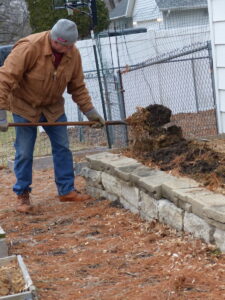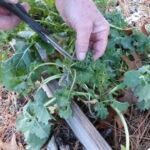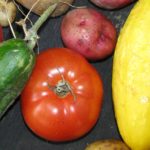Spring Ritual
After this weird winter, most of us in North America are simply ready for spring and want to get outside. Some folks take initiative and start garden and flower seeds indoors then transfer them outside when the weather moderates.
Are you ready to work the land? Try something new: No-till Gardening.

A rite of spring.
For generations, an April ritual all across the northern hemisphere is pulling the spading fork out of storage and firing up the rototiller. For generations, gardeners have learned from mentors, books, and videos that tilling is essential to create an abundant harvest of tomatoes, peas, beans, carrots, and so many other delicious garden vegetables.
Over decades and diligent research, we have learned that tilling is often just extra work that might harm the soil! Try no-till gardening.
Science Writer Shares Information
We recently heard science writer, author, and land steward Connie Mutel speak about how Iowa’s amazingly productive topsoil is being degraded by annual plowing and otherwise disturbing the soil. Mechanically mixing soil bares the soil to the air, where it oxygenates, leaching carbon into the atmosphere. When winds blow or rains fall, bare soil erodes. Waterways become contaminated and silt washes downstream eventually to the Mississippi Delta resulting in damage to commercial fisheries and wildlife there. According to Mutel, half of Iowa’s once 16-inch veneer of topsoil has been lost by tillage. For much more information check out her books available at the University of Iowa Press-uipress@uiowa.edu.
Reduce Runoff and Work
Most people aren’t farmers but many of us have backyard gardens. An annual activity is tilling. For years we followed conventional wisdom and used our trusty spading fork to turn over the soil each spring. Not so much anymore.
Last year encouraged by Drew Erickson, Farm Manager, of the Rodale Institute’s Midwest Organic Center, we left about half the garden untilled. “Tilling disrupts the organisms that make soil healthy and productive. “Try no-till gardening. Just plant your seeds in untilled soil,” he advised.
Last spring we tilled half the garden, smoothed out the soil, and planted our seeds.
We didn’t till the other half and just planted the seeds directly into the soil. A few months later we harvested at least as many vegetables from the no-tilled areas as the tilled……and we’d avoided the pitchfork work.
- We planted kale directly into the ground with good results.
- Summertime meal from the garden.
This year we’ll only till about a quarter of our garden. Into the rest we’ll plant our seeds and spread a layer of compost directly on the soil surface after the sprouts emerge.
We’re counting on bountiful harvests of many vegetables.
Join the Project
Give it a try. Put onion and potato sets, tomato plants, and bean seeds directly into the untilled garden soil. Let us know the results.
Learn More
Rodale Midwest is holding a free field day to show the value of minimum tillage and cover crops. It’s geared for farmers but gardeners are welcome. To register for the July 9, 2024, workshop go to the Rodale Institute Midwest Organic Center.
Have fun in the garden and enjoy a season of delicious vegetables.



